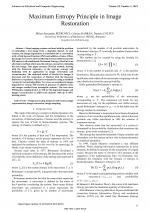| 2/2018 - 10 |
Maximum Entropy Principle in Image RestorationPETROVICI, M.-A. |
| Extra paper information in |
| Click to see author's profile in |
| Download PDF |
Author keywords
image processing, image reconstruction, image representation, image restoration, image sampling
References keywords
entropy(20), maximum(18), image(13), reconstruction(7), method(6), methods(5), data(5), astronomical(5), restoration(4), imaging(4)
Blue keywords are present in both the references section and the paper title.
About this article
Date of Publication: 2018-05-31
Volume 18, Issue 2, Year 2018, On page(s): 77 - 84
ISSN: 1582-7445, e-ISSN: 1844-7600
Digital Object Identifier: 10.4316/AECE.2018.02010
Web of Science Accession Number: 000434245000010
SCOPUS ID: 85047876823
Abstract
Many imaging systems are faced with the problem of estimating a true image from a degraded dataset. In such systems, the image degradation is translated into a convolution with a Point Spread Function (PSF) and addition of noise. Often, the image recovery by inverse filtering is not possible because the PSF matrix is ill-conditioned. Maximum Entropy (MaxEnt) is an alternative method, which uses the entropy concept for estimating the true image. This paper presents MaxEnt method, starting with the historical references of the entropy concept and finalizing with its application in image restoration and reconstruction. The statistical model of MaxEnt for images is discussed and the connection of MaxEnt with the Bayesian inference is explained. MaxEnt is evaluated by using a modified version of Cornwell algorithm. Two cases are considered: images degraded by various PSF kernels in presence of additive noise and images resulted from incomplete datasets. The tests show PSNR gains ranging from 1 to 7dB for the degraded images and images reconstructed at 25dB from datasets with up to 80% missing pixels. |
| References | | | Cited By |
Web of Science® Times Cited: 3 [View]
View record in Web of Science® [View]
View Related Records® [View]
Updated today
SCOPUS® Times Cited: 3
View record in SCOPUS® [Free preview]
View citations in SCOPUS® [Free preview]
[1] Knock-on deuteron imaging for diagnosing the morphology of an ICF implosion at OMEGA, Kunimune, J. H., Rinderknecht, H. G., Adrian, P. J., Heuer, P. V., Regan, S. P., Séguin, F. H., Gatu Johnson, M., Bahukutumbi, R. P., Knauer, J. P., Bachmann, B. L., Frenje, J. A., Physics of Plasmas, ISSN 1070-664X, Issue 7, Volume 29, 2022.
Digital Object Identifier: 10.1063/5.0096786 [CrossRef]
[2] Examining and Mitigating Kernel Saturation in Convolutional Neural Networks using Negative Images, Gowdra, Nidhi, Sinha, Roopak, MacDonell, Stephen, IECON 2020 The 46th Annual Conference of the IEEE Industrial Electronics Society, ISBN 978-1-7281-5414-5, 2020.
Digital Object Identifier: 10.1109/IECON43393.2020.9255147 [CrossRef]
[3] Examining convolutional feature extraction using Maximum Entropy (ME) and Signal-to-Noise Ratio (SNR) for image classification, Gowdra, Nidhi, Sinha, Roopak, MacDonell, Stephen, IECON 2020 The 46th Annual Conference of the IEEE Industrial Electronics Society, ISBN 978-1-7281-5414-5, 2020.
Digital Object Identifier: 10.1109/IECON43393.2020.9254346 [CrossRef]
Disclaimer: All information displayed above was retrieved by using remote connections to respective databases. For the best user experience, we update all data by using background processes, and use caches in order to reduce the load on the servers we retrieve the information from. As we have no control on the availability of the database servers and sometimes the Internet connectivity may be affected, we do not guarantee the information is correct or complete. For the most accurate data, please always consult the database sites directly. Some external links require authentication or an institutional subscription.
Web of Science® is a registered trademark of Clarivate Analytics, Scopus® is a registered trademark of Elsevier B.V., other product names, company names, brand names, trademarks and logos are the property of their respective owners.
Faculty of Electrical Engineering and Computer Science
Stefan cel Mare University of Suceava, Romania
All rights reserved: Advances in Electrical and Computer Engineering is a registered trademark of the Stefan cel Mare University of Suceava. No part of this publication may be reproduced, stored in a retrieval system, photocopied, recorded or archived, without the written permission from the Editor. When authors submit their papers for publication, they agree that the copyright for their article be transferred to the Faculty of Electrical Engineering and Computer Science, Stefan cel Mare University of Suceava, Romania, if and only if the articles are accepted for publication. The copyright covers the exclusive rights to reproduce and distribute the article, including reprints and translations.
Permission for other use: The copyright owner's consent does not extend to copying for general distribution, for promotion, for creating new works, or for resale. Specific written permission must be obtained from the Editor for such copying. Direct linking to files hosted on this website is strictly prohibited.
Disclaimer: Whilst every effort is made by the publishers and editorial board to see that no inaccurate or misleading data, opinions or statements appear in this journal, they wish to make it clear that all information and opinions formulated in the articles, as well as linguistic accuracy, are the sole responsibility of the author.



